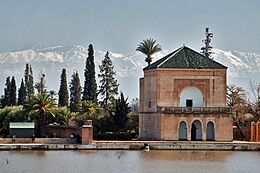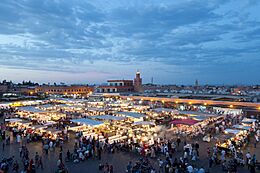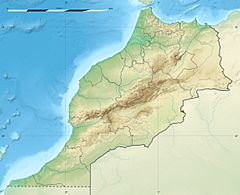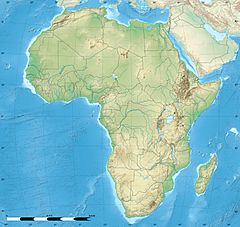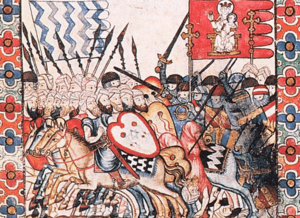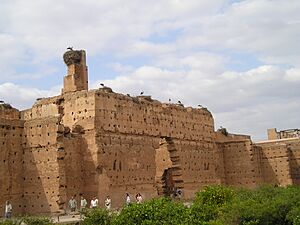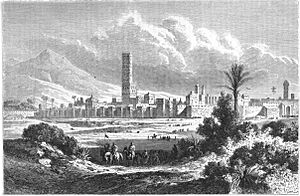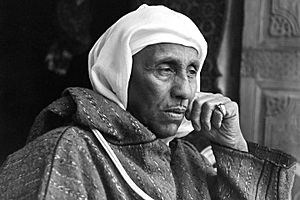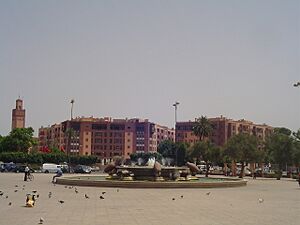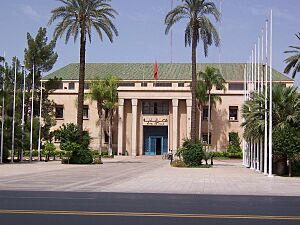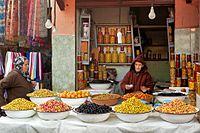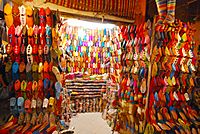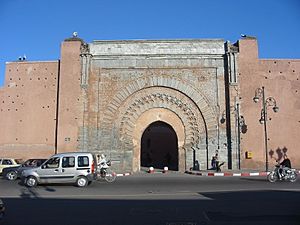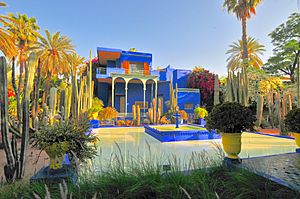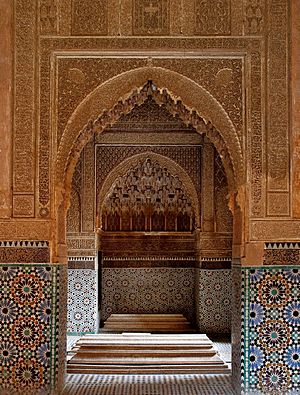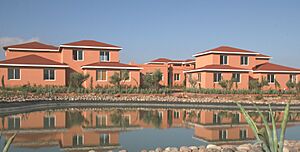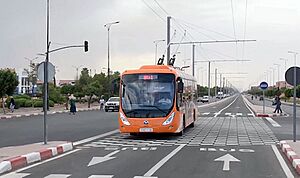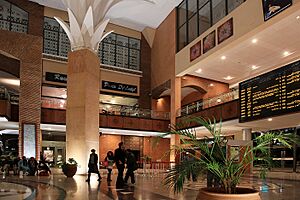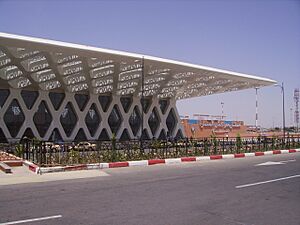Marrakesh facts for kids
Quick facts for kids
Marrakesh
مراكش
|
|
|---|---|
|
Clockwise, from top: Menara Gardens, Majorelle Garden, Kutubiyya Mosque, Jemaa el-Fnaa
|
|
| Country | |
| Region | Marrakesh-Safi |
| Prefecture | Marrakesh |
| Established | 1070 |
| Founded by | Abu Bakr ibn Umar |
| Elevation | 466 m (1,529 ft) |
| Population
(2014)
|
|
| • Total | 928,850 |
| • Rank | 4th in Morocco |
| Demonym(s) | Marrakshi |
| Time zone | UTC+1 (CET) |
| UNESCO World Heritage Site | |
| Official name | Medina of Marrakesh |
| Criteria | Cultural: i, ii, iv, v |
| Inscription | 1985 (9th Session) |
| Area | 1,107 ha |
Marrakesh (also spelled Marrakech) is a famous city in Morocco. It is the fourth-largest city in the country. Marrakesh is one of Morocco's four imperial cities, which means it was once a capital city. It is located west of the Atlas Mountains.
The city was started in 1070 by Emir Abu Bakr ibn Umar. He made it the capital of the Almoravid dynasty. The Almoravids built many of the city's first important structures. The red walls and buildings made of red sandstone gave Marrakesh its nickname: the "Red City" or "Ochre City." Marrakesh grew quickly and became a major center for culture, religion, and trade in the Maghreb region.
After a time, the city became less important than Fez. But in the 16th century, Marrakesh became important again. It was the capital for the Saadian dynasty. Sultans like Abdallah al-Ghalib and Ahmad al-Mansur built beautiful palaces, such as the El Badi Palace. They also fixed many old buildings. From the 17th century, Marrakesh became a popular place for Sufi pilgrims. They came to visit the tombs of the city's seven patron saints. In 1912, France took control of Morocco. T'hami El Glaoui became the Pasha of Marrakesh. He held this role until Morocco became independent in 1956.
Marrakesh has an old, walled city called the medina quarter. It is full of vendors and their stalls. This medina is a UNESCO World Heritage Site. Marrakesh is one of the busiest cities in Africa. Its main square, Jemaa el-Fnaa, is the busiest square on the continent. The city is a big economic center and a popular place for tourists. Many new hotels and buildings have been built in Marrakesh since 2000. It is especially popular with French visitors. Marrakesh has the largest traditional market (called a souk) in Morocco, with about 18 different souks. Many people in the city work in crafts, selling their goods to tourists.
Marrakesh has its own airport, Ménara International Airport. It also has a railway station that connects it to Casablanca and northern Morocco. The city is home to several universities, including Cadi Ayyad University. Many Moroccan football clubs are based here. The Marrakesh Street Circuit hosts international car races.
Contents
- What's in a Name?
- A Look Back: History of Marrakesh
- Exploring Marrakesh: Geography and Climate
- Who Lives in Marrakesh?
- Marrakesh's Economy
- How Marrakesh is Governed
- Famous Places to Visit in Marrakesh
- Culture and Fun in Marrakesh
- Learning in Marrakesh: Education
- Sports and Fun Activities
- Getting Around: Transport
- Staying Healthy: Healthcare
- Marrakesh Around the World
- Famous People from Marrakesh
- See also
What's in a Name?
The exact meaning of the name Marrakesh is still debated. One idea is that it comes from the Berber words amur (n) akush, which means "Land of God." Another idea from an old manuscript says it means "country of the sons of Kush."
For a long time, from the Middle Ages until the early 1900s, the whole country of Morocco was known as the "Kingdom of Marrakesh." Even today, in languages like Persian and Urdu, Morocco is still called "Marrakesh." Many European names for Morocco, like Marruecos or Maroc, also come from the name Murrākush. In the past, visitors sometimes called the city itself "Marocco City."
Marrakesh has many nicknames. It's known as the "Red City" or "Ochre City" because of its red walls and buildings. It's also called "the Daughter of the Desert."
A Look Back: History of Marrakesh
The area around Marrakesh has been home to Berber farmers since ancient times. Marrakesh was founded in 1070 by Abu Bakr ibn Umar. He was a leader and cousin of the Almoravid king Yusuf ibn Tashfin.

The Almoravids were a Berber group who wanted to improve Islamic society. They ruled a large area from Senegal to Spain. They made Marrakesh their capital. They built the first major buildings, including mosques and a fort called Ksar al-Hajjar. These early buildings shaped how the city looked for centuries. For example, the famous Jemaa el-Fnaa square started as an open space in front of the Almoravid palace. The city's markets (souks) grew in this area. Marrakesh quickly became a trading, cultural, and religious center.
Craftsmen from Spain helped build and decorate many monuments. They brought a special style with carved domes and arches. This style mixed with designs from the Sahara, creating a unique Marrakesh look. Yusuf ibn Tashfin brought gold and silver to the city. His son, Ali Ibn Yusuf, built the Ben Youssef Mosque between 1120 and 1132. He also built the city walls in 1126–1127. He improved the water supply with an underground system called the khettara.
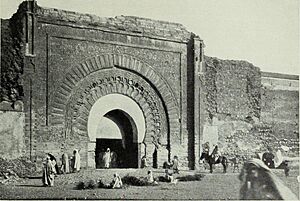
In 1125, a preacher named Ibn Tumart started the Almohad movement. This group fought against the Almoravids. In 1147, the Almohads captured Marrakesh after a long fight. They made it their new capital. They built the Kutubiyya Mosque next to the old Almoravid palace. The Almohads also started the Menara Gardens in 1157 and the Agdal Gardens. Ya'qub al-Mansur built the Kasbah, a fortress and palace area on the south side of the city. This was the center of government. The Almohads also improved the water system for their gardens. Marrakesh became a home for many writers and thinkers, including the famous philosopher Averroes.
After 1224, Marrakesh faced some difficult times. Different groups fought for control of the city. In 1269, nomadic tribes called the Zenata took over Marrakesh. The city then declined and lost its status as capital to Fez.
In the early 16th century, Marrakesh became the capital of Morocco again. This happened during the time of the Saadian sultans. The city quickly became important once more. Sultans like Abdallah al-Ghalib and Ahmad al-Mansur made Marrakesh beautiful with grand palaces. The El Badi Palace, started in 1578, was built with expensive materials like marble from Italy. This palace was used for fancy parties to show off Morocco's power. Under the Saadian dynasty, Marrakesh had a "golden age." It became a key stop for trade routes connecting North Africa, the Mediterranean, and West Africa.
For centuries, Marrakesh has been known for the tombs of Morocco's seven patron saints. These saints are important figures in sufism. During the late 17th century, a festival for these saints was started. People visit the tombs of the saints in a special order. This pilgrimage is now a well-known tradition.
In the early 1900s, Marrakesh faced more challenges. In 1912, France took control of Morocco. After some battles, the French took Marrakesh. This was helped by local leaders from the Glaoui family.
T'hami El Glaoui became the Pasha of Marrakesh. He was known as "Lord of the Atlas." He controlled the city for almost the entire time France ruled Morocco (1912–1956). Glaoui worked closely with the French authorities. However, he could not stop the rise of Moroccan nationalism. In 1956, Morocco gained its independence. This ended Glaoui's rule over Marrakesh.
Since Morocco became independent, Marrakesh has become a very popular place for tourists. In the 1960s and early 1970s, it was a trendy spot for "hippies." Many famous Western musicians, artists, and actors visited the city. Yves Saint Laurent, The Beatles, and The Rolling Stones all spent time here. Laurent even bought a property and helped restore the Majorelle Gardens. Many people from other countries, especially France, have invested in Marrakesh. They have restored old buildings in the Medina and built new homes and hotels.
United Nations groups started working in Marrakesh in the 1970s. This helped the city become more known internationally. In 1985, UNESCO named the old town of Marrakesh a UNESCO World Heritage Site. This helped people around the world learn about the city's culture. In 1994, the Marrakesh Agreement was signed here. This agreement created the World Trade Organisation. In 1997, Marrakesh hosted the first World Water Forum.
In the 21st century, building and real estate in the city have grown a lot. Many new hotels and shopping centers have opened. This is part of a plan by King Mohammed VI to bring more tourists to Morocco. In 2016, Marrakesh hosted a big climate change conference. In September 2023, the city was affected by a deadly earthquake.
Exploring Marrakesh: Geography and Climate

Marrakesh is located about 580 kilometers (360 miles) southwest of Tangier. It is 327 kilometers (203 miles) southwest of Rabat, the capital of Morocco. The city has grown outwards from its old center.
The city is in the Tensift River valley. The Tensift River flows along the northern edge of the city. The Ourika River valley is about 30 kilometers (19 miles) south of Marrakesh. The Atlas Mountains are about 25–30 kilometers (15–20 miles) from the city. These mountains are very tall, with an average height of over 3,000 meters (9,800 feet). In winter, they are covered in snow.
Marrakesh is like an oasis with lots of green spaces. It has 130,000 hectares (320,000 acres) of greenery and over 180,000 palm trees. Throughout the year, you can see fragrant orange, fig, pomegranate, and olive trees. These are in places like Agdal Garden and Menara Garden. The city's gardens have many native plants. They also have plants brought from other places over time. These include giant bamboos, yuccas, papyrus, palm trees, banana trees, and different kinds of cactus plants.
Weather in Marrakesh
Marrakesh has a hot, semi-dry climate. This means it has long, hot, dry summers and short, mild to cool winters. Average temperatures range from 12°C (54°F) in winter to 26–30°C (79–86°F) in summer. The city gets less rain than places with a typical Mediterranean climate.
| Climate data for Marrakesh, Morocco (Menara International Airport) 1991–2020, extremes 1900–present | |||||||||||||
|---|---|---|---|---|---|---|---|---|---|---|---|---|---|
| Month | Jan | Feb | Mar | Apr | May | Jun | Jul | Aug | Sep | Oct | Nov | Dec | Year |
| Record high °C (°F) | 30.1 (86.2) |
34.3 (93.7) |
37.0 (98.6) |
39.6 (103.3) |
44.4 (111.9) |
46.9 (116.4) |
49.6 (121.3) |
48.6 (119.5) |
44.8 (112.6) |
39.8 (103.6) |
35.2 (95.4) |
30.9 (87.6) |
49.6 (121.3) |
| Mean daily maximum °C (°F) | 19.1 (66.4) |
20.7 (69.3) |
23.6 (74.5) |
25.7 (78.3) |
29.4 (84.9) |
33.6 (92.5) |
37.7 (99.9) |
37.4 (99.3) |
32.5 (90.5) |
28.5 (83.3) |
23.1 (73.6) |
20.1 (68.2) |
27.6 (81.7) |
| Daily mean °C (°F) | 12.5 (54.5) |
14.2 (57.6) |
17.0 (62.6) |
19.0 (66.2) |
22.3 (72.1) |
25.8 (78.4) |
29.2 (84.6) |
29.3 (84.7) |
25.6 (78.1) |
22.1 (71.8) |
16.9 (62.4) |
13.7 (56.7) |
20.6 (69.1) |
| Mean daily minimum °C (°F) | 5.9 (42.6) |
7.6 (45.7) |
10.3 (50.5) |
12.4 (54.3) |
15.2 (59.4) |
17.9 (64.2) |
20.6 (69.1) |
21.1 (70.0) |
18.6 (65.5) |
15.7 (60.3) |
10.7 (51.3) |
7.3 (45.1) |
13.6 (56.5) |
| Record low °C (°F) | −3.6 (25.5) |
−3.0 (26.6) |
0.4 (32.7) |
2.8 (37.0) |
6.8 (44.2) |
9.0 (48.2) |
10.4 (50.7) |
6.0 (42.8) |
10.0 (50.0) |
1.1 (34.0) |
0.0 (32.0) |
−1.6 (29.1) |
−3.6 (25.5) |
| Average precipitation mm (inches) | 25.0 (0.98) |
25.7 (1.01) |
35.2 (1.39) |
26.3 (1.04) |
10.5 (0.41) |
3.1 (0.12) |
2.2 (0.09) |
4.7 (0.19) |
15.2 (0.60) |
19.1 (0.75) |
29.8 (1.17) |
24.2 (0.95) |
221.0 (8.70) |
| Average precipitation days (≥ 1.0 mm) | 3.0 | 3.7 | 4.7 | 2.9 | 1.5 | 0.6 | 0.3 | 0.8 | 1.3 | 2.4 | 3.8 | 4.1 | 29.1 |
| Average relative humidity (%) | 65 | 66 | 61 | 60 | 58 | 55 | 47 | 47 | 52 | 59 | 62 | 65 | 58 |
| Mean monthly sunshine hours | 230.1 | 216.5 | 252.8 | 270.2 | 303.1 | 359.7 | 330.4 | 315.1 | 266.8 | 251.5 | 228.9 | 226.6 | 3,251.7 |
| Source 1: NOAA (sun 1981–2010) | |||||||||||||
| Source 2: Deutscher Wetterdienst (record highs for February, April, May, September and November, and humidity), Meteo Climat (record highs and record lows for June, July and August only) | |||||||||||||
| Climate data for Marrakesh | |||||||||||||
|---|---|---|---|---|---|---|---|---|---|---|---|---|---|
| Month | Jan | Feb | Mar | Apr | May | Jun | Jul | Aug | Sep | Oct | Nov | Dec | Year |
| Mean daily daylight hours | 10.0 | 11.0 | 12.0 | 13.0 | 14.0 | 14.0 | 14.0 | 13.0 | 12.0 | 11.0 | 11.0 | 10.0 | 12.1 |
| Average Ultraviolet index | 3 | 5 | 7 | 8 | 10 | 11 | 11 | 10 | 9 | 6 | 4 | 3 | 7.3 |
| Source: Weather Atlas | |||||||||||||
Climate Change Impact
A study in 2019 looked at how climate change might affect Marrakesh. It suggested that by 2050, Marrakesh's climate could become much hotter. The average yearly temperature might go up by 2.9°C (5.2°F). The temperature of the warmest month could increase by 7°C (12.6°F).
Water Supply
Marrakesh gets its water partly from underground sources. These water levels have been dropping for the last 40 years. This drop became very noticeable in the early 2000s. Since 2002, underground water levels have gone down by about 0.9 meters (3 feet) each year in most of the Marrakesh area.
Who Lives in Marrakesh?
In 2014, the population of Marrakesh was 928,850 people. This was an increase from 843,575 people in 2004.
Marrakesh's Economy
Marrakesh is very important to Morocco's economy and culture. Better roads to Casablanca, Agadir, and the airport have led to a huge increase in tourism. Now, over two million tourists visit the city every year. Because tourism is so important, King Mohammed VI wants to double the number of tourists visiting Morocco to 20 million by 2020.
The city is very popular with French visitors. Many French celebrities have bought homes there. In the 1990s, few foreigners lived in Marrakesh. But in the last 15 years, many more have bought properties. By 2005, over 3,000 foreigners had bought homes in the city. They were attracted by its culture and lower house prices.
Even with the tourism boom, many people in the city are still poor. In 2010, about 20,000 homes still did not have access to water or electricity.
New hotels and resorts are being built. For example, Royal Ranches Marrakech is a large resort being developed. It is expected to create many jobs and bring in thousands of visitors.
Avenue Mohammed VI is a main road in the city. It has seen many new homes and luxury hotels built. This avenue also has a large nightclub called Pacha Marrakech. There are also two big movie theaters and a new shopping center called Al Mazar.
Trade and crafts are very important to the local economy, especially because of tourism. Marrakesh has 18 souks (markets). Over 40,000 people work in crafts like pottery, copperware, leather, and more. The souks sell a huge variety of items. Bargaining for prices is a very important part of shopping in the souks.
One of the biggest souks is Souk Semmarine. It sells everything from colorful sandals to jewelry. Souk Ableuh sells lemons, chilies, olives, and mint. Souk Kchacha specializes in dried fruits and nuts. Rahba Qedima has hand-woven baskets and natural perfumes. The Criée Berbère is known for its Berber carpets. Souk Siyyaghin sells jewelry, and Souk Smata has many babouches (traditional slippers). Souk Cherratine specializes in leather goods, and Souk Haddadine sells ironware and lanterns. The Medina is also famous for its street food. Mechoui Alley is known for its slow-roasted lamb dishes.
Marrakesh has several supermarkets and three major shopping centers. Industrial production is in the Sidi Ghanem Al Massar area. This area has factories, workshops, and showrooms.
Marrakesh is one of North Africa's biggest centers for wildlife trade. This happens even though most of this trade is illegal. You can find tortoises, Barbary macaques, and snakes for sale in the medina. Sadly, most of these animals are not kept in good conditions.
How Marrakesh is Governed
Marrakesh is the capital of the Marrakesh-Safi region. It is a major center for law and justice in Morocco. Most of the region's main courts are located here. Many regional organizations are also based in Marrakesh.
On June 12, 2009, Fatima-Zahra Mansouri was elected as the first female mayor of Marrakesh. She was a 33-year-old lawyer. Mansouri became the second woman in Morocco's history to be a mayor. She was re-elected in September 2021.
Since 2011, the ruling political party in Marrakesh has been the Justice and Development Party (PDJ). This party also leads the national government.
Famous Places to Visit in Marrakesh
Jemaa el-Fnaa Square

The Jemaa el-Fnaa is one of the most famous squares in Africa. It is the heart of city life and trade. It has been called a "world-famous square" and a "bridge between the past and the present." It became a UNESCO World Heritage Site in 1985.
The name of the square might mean "ruined mosque." This refers to a mosque built in the late 16th century that was never finished. The square was originally a market space in front of the Almoravid palace. Even after a new palace was built, the market square remained.
In the past, this square was used for public executions. It attracted people from the desert and mountains who came to trade. Today, the square attracts people from all walks of life and tourists from around the world. You can still see snake charmers, acrobats, magicians, musicians, monkey trainers, storytellers, and other entertainers here.
Marrakesh Markets (Souks)
Marrakesh has the largest traditional market in Morocco. The city is well-known for its souks. Historically, the souks were divided into areas for specific goods, like leather or carpets. These divisions still mostly exist today. Many souks sell items like carpets, traditional clothes, leather bags, and lanterns. Haggling (bargaining for a price) is a very important part of shopping in the souks.
Souk Semmarine is one of the largest souks. It sells everything from sandals to jewelry. Souk Ableuh specializes in lemons, chilies, olives, and mint. Souk Kchacha sells dried fruits and nuts. Rahba Qedima has hand-woven baskets and natural perfumes. The Criée Berbère is known for its Berber carpets. Souk Siyyaghin is famous for jewelry, and Souk Smata for its slippers. Souk Cherratine sells leather goods, and Souk Haddadine specializes in ironware and lanterns.
The Medina is also famous for its street food. Mechoui Alley is known for its slow-roasted lamb. The Ensemble Artisanal is a government-run complex near the Koutoubia Mosque. It offers a variety of crafts. Young people learn different crafts in workshops here.
City Walls and Gates
The walls of Marrakesh stretch for about 19 kilometers (12 miles) around the old city (medina). They were built by the Almoravids in the 12th century to protect the city. The walls are made of a special orange-red clay and chalk. This gives the city its nickname, the "red city." The walls are up to 6 meters (19 feet) high and have 20 gates and 200 towers.
One of the most famous gates is Bab Agnaou. It was built in the late 12th century. It was the main public entrance to the new Kasbah (fortress). The gate has beautiful floral decorations. It also has an inscription from the Quran written in a special style.
The medina has at least eight main historic gates. These include Bab Doukkala, Bab el-Khemis, Bab ad-Debbagh, Bab Aylan, Bab Aghmat, Bab er-Robb, Bab el-Makhzen, and Bab el-'Arissa. They date back to the 12th century. Bab Doukkala is in the northwest part of the wall. Bab el-Khemis is in the northeast corner. It is named after the Thursday market. Bab ad-Debbagh, to the east, has a very complex design. Bab Aghmat and Bab er Robb are main southern gates.
Beautiful Gardens

Marrakesh is home to many gardens, both old and new. The largest and oldest are the Menara Gardens and the Agdal Gardens. The Menara Gardens were created in 1157. They have a large water reservoir surrounded by orchards and olive groves. A 19th-century building stands by the reservoir. The Agdal Gardens are even larger and have several water basins. Water for both gardens came from the Atlas Mountains through an old system called khettaras.
The Majorelle Garden used to be the home of painter Jacques Majorelle. Famous designer Yves Saint Laurent bought and restored it. The garden has a large collection of plants from five continents. It also has a museum of Islamic art.
The Koutoubia Mosque is surrounded by the Koutoubia Gardens. These gardens have orange and palm trees. The Mamounia Gardens are over 100 years old. They have olive and orange trees and beautiful flowers. In 2016, artist André Heller opened the ANIMA garden. It combines many plants with art by famous artists.
Palaces and Riads

Marrakesh has many grand palaces and mansions. The most famous palaces are the El Badi Palace and the Bahia Palace. The main Royal Palace is still used by the King of Morocco.
Riads are traditional Moroccan mansions. They are built around an open central garden courtyard. High walls surround them for privacy and to keep the building cool. Many riads can be found in the old city. Some date back to the 16th and 17th centuries.
Important Mosques
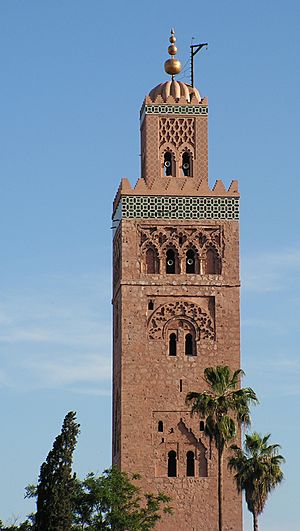
The Koutoubia Mosque is one of the largest and most famous mosques in the city. It was founded in 1147. The mosque was rebuilt around 1158. Its tall minaret tower, 77 meters (253 feet) high, is a major landmark of Marrakesh. It likely influenced other famous buildings like the Giralda in Seville.
Ben Youssef Mosque is named after the Almoravid sultan Ali ibn Yusuf. He built the original mosque in the 12th century. It was the city's main mosque for Friday prayers. The 16th-century Ben Youssef Madrasa (school) is next to it. Also nearby is the Koubba Ba’adiyn, a rare building from the Almoravid period.
The Kasbah Mosque was built in the late 12th century. It was the main mosque for the kasbah (citadel) where the rulers lived. Its minaret's design was very influential in Moroccan architecture. The Saadian Tombs were built just outside its southern wall.
Other important mosques include the 14th-century Ben Salah Mosque. The Mouassine Mosque was built between 1562 and 1573. It was part of a larger complex with a library, public bathhouse, and school. This complex also included a beautiful public fountain. The Bab Doukkala Mosque, built around the same time, has a similar design.
Tombs of Saints and Rulers
The Saadian Tombs are famous burial sites in the city. They were built in the 16th century for the Saadian Dynasty. They are located next to the Kasbah Mosque. Many Saadian rulers are buried here. The tombs have two main buildings within a garden. The most important graves have finely carved marble tombstones. The mausoleum of Al-Mansur is very richly decorated. It has a cedar wood roof and marble columns.
The city also has the tombs of many Sufi figures. There are seven patron saints of the city. Pilgrims visit their tombs every year during a seven-day journey called the ziara. Many of these tombs are part of zawiyas, which are Sufi religious centers.
The Mellah (Jewish Quarter)
The Mellah of Marrakesh is the old Jewish Quarter of the city. It is located in the kasbah area of the medina. It was created in 1558. At that time, many Jewish people in the city were tailors, metalworkers, bankers, and traders. The Mellah had its own fountains, gardens, synagogues, and markets. Until 1912, Jewish people could not own property outside the Mellah. This led to narrow streets and small shops inside the neighborhood.
Today, the Mellah is mostly a residential area for Muslims. The Slat al-Azama Synagogue is in the Mellah. The Jewish cemetery here is the largest in Morocco. It has white-washed tombs.
Hotels in Marrakesh
As a major tourist city, Marrakesh has over 400 hotels. The Mamounia Hotel is a famous five-star hotel. It was built in 1925. It is considered the most important hotel in the city. Many famous people have stayed there, including Winston Churchill and Mick Jagger. The hotel has 231 rooms and a casino. Other hotels include Eden Andalou Hotel and Sofitel Marrakech.
Culture and Fun in Marrakesh
Museums to Explore
Marrakech Museum
The Marrakech Museum is in the Dar Menebhi Palace. This palace was built in the early 1900s. It was carefully restored and opened as a museum in 1997. The palace itself is a beautiful example of traditional architecture. It has fountains, seating areas, and detailed tilework. The museum shows both modern and traditional Moroccan art. It also has old books, coins, and pottery from Jewish, Berber, and Arab peoples.
Dar Si Said Museum
The Dar Si Said Museum, also called the Museum of Moroccan Arts, is near the Bahia Palace. It was once the mansion of Si Said. The museum has one of the best collections in Morocco. It includes jewelry, carpets, oil lamps, pottery, and leatherwork. One of its oldest items is a marble basin from the 11th century.
Berber Museum
The old home of Jacques Majorelle, a blue building in the Majorelle Gardens, became the Berber Museum in 2011. It shows many objects from the Amazigh (Berber) culture from different parts of Morocco.
Other Museums
The House of Photography of Marrakech opened in 2009. It shows old Moroccan photos from the 1870s to the 1950s. The Mouassine Museum is in a historic 16th-century house. It opened as a museum and cultural center in 2014. Since 2020, it has also been a museum of Moroccan music.
The Dar El Bacha hosts the Musée des Confluences. This museum opened in 2017. It has temporary exhibits about Moroccan culture and art from around the world. The Tiskiwin Museum has items from the old trade routes that connected to Marrakesh. There are also other small museums, like the Musée Boucharouite and the Perfume Museum.
Outside the old city, in Gueliz, you can find more art galleries. The Museum of Art and Culture of Marrakesh (MACMA) opened in 2016. It has Moroccan art and photography. The Museum of African Contemporary Art Al Maaden (MACAAL) shows modern Moroccan and African art. The Yves Saint Laurent Museum opened in 2017. It displays the work of the French fashion designer Yves Saint Laurent.
Music, Theatre, and Dance
Two types of music are common in Marrakesh. Berber music is influenced by classical music from Spain. It often uses an oud (a stringed instrument). Gnaoua music is loud and lively. It uses handmade instruments like castanets and drums. This music is said to have started in Marrakesh and Essaouira.
The Théâtre Royal de Marrakesh and the Institut Français are major places for performing arts. The Théâtre Royal hosts plays, operas, and dances in French and Arabic. Many theater groups also perform outdoors in the main square, especially at night.
Amazing Crafts
The crafts of Marrakesh have had a big impact on Moroccan handicrafts. You can see riad designs in carpets, textiles, ceramics, and metalwork. Moroccan women who are expert craftspeople are called Maalems. They make beautiful products like Berber carpets and shawls.
Wood crafts are often made from cedar. This includes doors and palace ceilings. Orange wood is used for making ladles. Thuya craft products are made from a special caramel-colored wood.
Metalwork from Marrakesh includes brass lamps, iron lanterns, and engraved brass teapots. Contemporary art includes sculptures and paintings. Blue-veiled Tuareg figures and calligraphy paintings are also popular.
Festivals and Celebrations
Many national and Islamic festivals are celebrated in Marrakesh. Some are national holidays. Important cultural festivals include the National Folklore Festival and the Marrakech Festival of Popular Arts. These feature famous Moroccan musicians and artists. The International Film Festival of Marrakech started in 2001. It shows over 100 films each year and attracts Hollywood stars. The Marrakech Bienniale is a cultural festival that started in 2004. It includes visual arts, cinema, literature, and architecture.
Delicious Food
Marrakesh's food is rich and uses many spices, but it's not usually hot. It often uses Ras el hanout, a blend of dozens of spices. A special dish of the city is tanjia marrakshia. It's made with beef, spices, and smen (clarified butter). It's slow-cooked in a ceramic pot in hot ashes.
Tajines can be made with chicken, lamb, beef, or fish. They often include fruit, olives, vegetables, and spices. The meal is cooked slowly in a special tajine pot. Another version of tajine has vegetables and chickpeas with flower petals.
Shrimp, chicken, and lemon-filled briouats are another traditional dish. Rice is cooked with saffron, raisins, and almonds. Couscous can have added vegetables. A pastilla is a pastry filled with minced chicken or pigeon, almonds, cinnamon, and sugar. Harira soup usually has lamb, chickpeas, lentils, and tomato paste. Kefta (minced meat), liver, and merguez (sausage) are often sold at stalls in Jemaa el-Fnaa.
Desserts include chebakia (sesame spice cookies). These are often eaten during Ramadan. There are also tarts with dried fruit or cheesecake with dates.
Moroccan tea culture is very important in Marrakesh. Green tea with mint and sugar is served from a curved teapot. Orange juice is another popular non-alcoholic drink.
Learning in Marrakesh: Education
Marrakesh has several universities and schools. These include Cadi Ayyad University, which has 13 institutions in four cities. The École nationale des sciences appliquées de Marrakech (ENSA Marrakech) is part of this university. It focuses on engineering and science. Sup de Co Marrakech is a private college founded in 1987. It has partnerships with many American universities.
Ben Youssef Madrasa
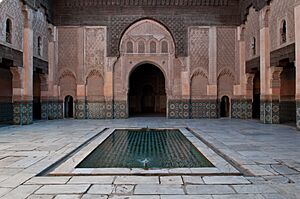
The Ben Youssef Madrasa is an Islamic college in Marrakesh. It is named after the sultan Ali ibn Yusuf. It is the largest madrasa in Morocco. It was once one of the biggest theological colleges in North Africa, housing up to 900 students.
This school focused on Quranic law. It was connected to similar schools in other cities. The madrasa was built by Sultan Abdallah al-Ghalib in 1564. Its 130 student rooms are around a courtyard. The courtyard is beautifully carved with cedar, marble, and stucco. The carvings only show inscriptions and geometric patterns, as is common in Islamic art. The building was closed in 1960 but reopened as a historical site in 1982.
Sports and Fun Activities
Football clubs in Marrakesh include Najm de Marrakech and KAC Marrakech. The city has the Circuit International Automobile Moulay El Hassan, a race track. It hosts international car races. The Marrakech Marathon is also held here every year. About 5,000 runners take part. The Grand Prix Hassan II tennis tournament is also held in Marrakesh. Marrakesh might even host matches for the 2030 FIFA World Cup.
Golf is a popular sport in Marrakesh. The city has three golf courses just outside its limits. These include the Golf de Amelikis, the Palmeraie Golf Palace, and the Royal Golf Club.
The Jnan Amar Polo Club is located near Marrakesh.
Getting Around: Transport
Bus System
Marrakesh has a bus rapid transit (BRT) system that opened in 2017. It uses trolleybuses.
Train Travel
The Marrakesh railway station has daily trains to other major Moroccan cities. These include Casablanca, Tangiers, Fez, Meknes, and Rabat. A high-speed train line to Casablanca and Tangier opened in 2018.
In 2015, there was a plan to build a tramway system in Marrakesh.
Roads
The main roads in and around Marrakesh are well-paved. The A7 is a major highway that connects Marrakesh to Casablanca in the north. It is a toll expressway, 210 kilometers (130 miles) long. The A7 also connects Marrakesh to Agadir in the southwest.
Air Travel
The Marrakesh-Menara Airport (RAK) is about 3 kilometers (2 miles) southwest of the city center. It is an international airport. It receives many flights from Europe, Casablanca, and other Arab nations. The airport has two passenger terminals that are combined into one large terminal. A third terminal is being built. The airport can handle 4.5 million passengers per year.
Staying Healthy: Healthcare
Marrakesh has always been an important center for healthcare in Morocco. People from both the city and nearby rural areas rely on its hospitals. In the 16th century, a psychiatric hospital was built in Marrakesh. It was considered one of the best in the world at the time.
The city's hospitals have faced challenges as the population has grown. Ibn Tofail University Hospital is one of the main hospitals. In 2001, the Moroccan government received a loan to improve medical services in Marrakesh. This led to expansions of Ibn Tofail and Ibn Nafess hospitals. New buildings and medical equipment were added.
In 2009, King Mohammed VI opened a new regional psychiatric hospital in Marrakesh. It cost about 2.7 million U.S. dollars. The king has also announced plans for a new military hospital in the city.
Marrakesh Around the World
Marrakesh is twinned with several cities around the world. This means they have special friendly relationships.
- Granada, Spain
- Marseille, France
- Granby, Canada
- Ningbo, China
- Scottsdale, United States
- Sousse, Tunisia
- Timbuktu, Mali
Famous People from Marrakesh
- Amine Amamou, footballer
- Ibn al-Banna' al-Marrakushi, a mathematician and astronomer from the 13th century
- Ibn Idhari, a historian from the 13th century
- Abdelwahid al-Marrakushi, a historian from the 13th century
- Abd el-Ouahed ben Messaoud, a Moroccan diplomat from the 16th century
- Ahmad ibn Qasim Al-Hajarī, a Morisco who escaped the Spanish Inquisition and became an ambassador for Morocco
- Abdelali Mhamdi, professional goalkeeper
- Ahmed Bahja - Former footballer
- Hasna Benhassi - Former middle-distance runner
- Tahar El Khalej - Former footballer
- Abdellah Jlaidi - footballer
- Adil Ramzi - Former footballer
- Salaheddine Saidi - footballer
- Tahar Tamsamani - Former boxer
See also
 In Spanish: Marrakech para niños
In Spanish: Marrakech para niños


